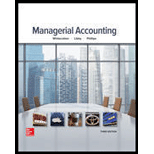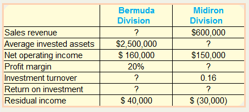
Managerial Accounting
3rd Edition
ISBN: 9780077826482
Author: Stacey M Whitecotton Associate Professor, Robert Libby, Fred Phillips Associate Professor
Publisher: McGraw-Hill Education
expand_more
expand_more
format_list_bulleted
Concept explainers
Textbook Question
Chapter 10, Problem 2.1GAP
Calculating Unknowns, Predicting Relationship among
The following is partial information for Charleston Company’s most recent year of operation. It manufactures Iawn mowers and categories operations into two divisions: Bermuda and Midiron.

Required:
Without making any calculations, determine whether each division's return on investment is above or below Charleston's hurdle rate. How can you tell?
Expert Solution & Answer
Want to see the full answer?
Check out a sample textbook solution
Students have asked these similar questions
I need assistance with this financial accounting problem using valid financial procedures.
Bowen Corporation had sales revenue of $925,000 and cost of goods sold of $555,000. Operating expenses were $245,000, which included depreciation expense of $35,000. The company also recorded interest expense of $28,000. What was Bowen Corporation's income before taxes?
Genshin Company uses process costing. During March, the packaging department had 8,500 units in beginning work-in-process inventory that were 70% complete. During the month, 42,000 units were started and 37,500 units were completed. Ending work-in-process inventory was 40% complete. Using the weighted-average method, what are the equivalent units for the month? Need help
Chapter 10 Solutions
Managerial Accounting
Ch. 10 - Explain how centralized and decentralized...Ch. 10 - Why does decentralization create the need for...Ch. 10 - What is the controllability principle and why is...Ch. 10 - Prob. 4QCh. 10 - Prob. 5QCh. 10 - Prob. 6QCh. 10 - Prob. 7QCh. 10 - Prob. 8QCh. 10 - Return on investment may be separated into two...Ch. 10 - Prob. 10Q
Ch. 10 - Prob. 11QCh. 10 - Prob. 12QCh. 10 - Prob. 13QCh. 10 - Prob. 14QCh. 10 - Prob. 15QCh. 10 - Prob. 16QCh. 10 - Prob. 17QCh. 10 - Why must a company consider its incentive and...Ch. 10 - Prob. 19QCh. 10 - Prob. 20QCh. 10 - Prob. 21QCh. 10 - Prob. 22QCh. 10 - Prob. 23QCh. 10 - Prob. 24QCh. 10 - Prob. 25QCh. 10 - What are negotiated transfer prices? Explain two...Ch. 10 - Sally Thorne is a profit center manager for ABC...Ch. 10 - Prob. 2MCCh. 10 - Which of the following statements is true? a. A...Ch. 10 - Prob. 4MCCh. 10 - Prob. 5MCCh. 10 - Prob. 6MCCh. 10 - Prob. 7MCCh. 10 - Prob. 8MCCh. 10 - Which of the following is not a component of the...Ch. 10 - Prob. 10MCCh. 10 - Using Terms to Complete Sentences about...Ch. 10 - Prob. 2MECh. 10 - Prob. 3MECh. 10 - Applying Balanced Scorecard to Real World Company...Ch. 10 - Applying Balanced Scorecard to Online Company...Ch. 10 - Prob. 6MECh. 10 - Prob. 7MECh. 10 - Prob. 8MECh. 10 - Prob. 9MECh. 10 - Prob. 10MECh. 10 - Prob. 11MECh. 10 - Prob. 12MECh. 10 - Prob. 13MECh. 10 - Prob. 2ECh. 10 - Prob. 3ECh. 10 - Prob. 4ECh. 10 - Calculating Return on Investment, Residual Income,...Ch. 10 - Prob. 6ECh. 10 - Evaluating Managerial Performance Using Return on...Ch. 10 - Evaluating Managerial Performance Using Return on...Ch. 10 - Prob. 9ECh. 10 - Determining the Impact of Various Transactions on...Ch. 10 - Determining Different Types of Responsibility...Ch. 10 - Prob. 14ECh. 10 - Prob. 15ECh. 10 - Prob. 16ECh. 10 - Matching Measures of Performance with the Correct...Ch. 10 - Determining Minimum, Maximum, Negotiated Transfer...Ch. 10 - Prob. 19ECh. 10 - Prob. 20ECh. 10 - Calculating Return on Investment, Residual Income,...Ch. 10 - Prob. 1.2GAPCh. 10 - Calculating Unknowns, Predicting Relationship...Ch. 10 - Calculating Unknowns, Predicting Relationship...Ch. 10 - Prob. 2.3GAPCh. 10 - Prob. 2.4GAPCh. 10 - Prob. 2.5GAPCh. 10 - Prob. 2.6GAPCh. 10 - Prob. 3.1GAPCh. 10 - Prob. 3.2GAPCh. 10 - Prob. 3.3GAPCh. 10 - Prob. 3.4GAPCh. 10 - Prob. 3.5GAPCh. 10 - Prob. 3.6GAPCh. 10 - Prob. 4.1GAPCh. 10 - Prob. 4.2GAPCh. 10 - Prob. 4.3GAPCh. 10 - Prob. 4.4GAPCh. 10 - Prob. 4.5GAPCh. 10 - Prob. 5.1GAPCh. 10 - Prob. 5.2GAPCh. 10 - Prob. 5.3GAPCh. 10 - Prob. 5.4GAPCh. 10 - Prob. 6GAPCh. 10 - Prob. 1.1GBPCh. 10 - Prob. 1.2GBPCh. 10 - Prob. 2.1GBPCh. 10 - Prob. 2.2GBPCh. 10 - Prob. 2.3GBPCh. 10 - Prob. 2.4GBPCh. 10 - Prob. 2.5GBPCh. 10 - Prob. 2.6GBPCh. 10 - Prob. 3.1GBPCh. 10 - Prob. 3.2GBPCh. 10 - Prob. 3.3GBPCh. 10 - Prob. 3.4GBPCh. 10 - Prob. 3.5GBPCh. 10 - Prob. 3.6GBPCh. 10 - Prob. 4.1GBPCh. 10 - Prob. 4.2GBPCh. 10 - Prob. 4.3GBPCh. 10 - Prob. 4.4GBPCh. 10 - Prob. 4.5GBPCh. 10 - Prob. 5.1GBPCh. 10 - Prob. 5.2GBPCh. 10 - Prob. 5.3GBPCh. 10 - Prob. 5.4GBPCh. 10 - Prob. 6GBP
Knowledge Booster
Learn more about
Need a deep-dive on the concept behind this application? Look no further. Learn more about this topic, accounting and related others by exploring similar questions and additional content below.Similar questions
- Can you solve this general accounting question with accurate accounting calculations?arrow_forwardIn 2019, Philip Industries sold 3,800 units at $275 each. Variable costs were $195 per unit, and fixed costs were $120,000. What was Philip Industries' 2019 net income?arrow_forwardPlease explain the correct approach for solving this financial accounting question.arrow_forward
- A machine costs $50,000 with a salvage value of $5,000 and a useful life of 5 years. Calculate the annual depreciation expense using straight-line, double-declining balance, and sum-of-years-digits methods.arrow_forwardNirvana Technologies has $85,000 in assets. They also have $32,000 in liabilities and $8,500 in expenses, and they paid out $10,000 in dividends this year. The extended accounting equation is assets = liabilities + (revenue - (expenses + dividends)). What would their revenue need to be for their accounts to be in balance?arrow_forwardI need help solving this general accounting question with the proper methodology.arrow_forward
- Please help me solve this general accounting question using the right accounting principles.arrow_forwardAbigail Industries uses a perpetual inventory system. Beginning inventory consisted of 600 units at $24 each. During the month, the following transactions occurred: Purchase #1: 800 units at $25; Sale #1: 900 units at $40; Purchase #2: 700 units at $26; Sale #2: 850 units at $42. Using the FIFO method, what is the gross profit for the month?arrow_forward4 MARKSarrow_forward
arrow_back_ios
SEE MORE QUESTIONS
arrow_forward_ios
Recommended textbooks for you
- Principles of Accounting Volume 2AccountingISBN:9781947172609Author:OpenStaxPublisher:OpenStax College
 Managerial AccountingAccountingISBN:9781337912020Author:Carl Warren, Ph.d. Cma William B. TaylerPublisher:South-Western College Pub
Managerial AccountingAccountingISBN:9781337912020Author:Carl Warren, Ph.d. Cma William B. TaylerPublisher:South-Western College Pub Financial And Managerial AccountingAccountingISBN:9781337902663Author:WARREN, Carl S.Publisher:Cengage Learning,
Financial And Managerial AccountingAccountingISBN:9781337902663Author:WARREN, Carl S.Publisher:Cengage Learning,  Survey of Accounting (Accounting I)AccountingISBN:9781305961883Author:Carl WarrenPublisher:Cengage Learning
Survey of Accounting (Accounting I)AccountingISBN:9781305961883Author:Carl WarrenPublisher:Cengage Learning

Principles of Accounting Volume 2
Accounting
ISBN:9781947172609
Author:OpenStax
Publisher:OpenStax College

Managerial Accounting
Accounting
ISBN:9781337912020
Author:Carl Warren, Ph.d. Cma William B. Tayler
Publisher:South-Western College Pub

Financial And Managerial Accounting
Accounting
ISBN:9781337902663
Author:WARREN, Carl S.
Publisher:Cengage Learning,

Survey of Accounting (Accounting I)
Accounting
ISBN:9781305961883
Author:Carl Warren
Publisher:Cengage Learning
Capital Budgeting Introduction & Calculations Step-by-Step -PV, FV, NPV, IRR, Payback, Simple R of R; Author: Accounting Step by Step;https://www.youtube.com/watch?v=hyBw-NnAkHY;License: Standard Youtube License